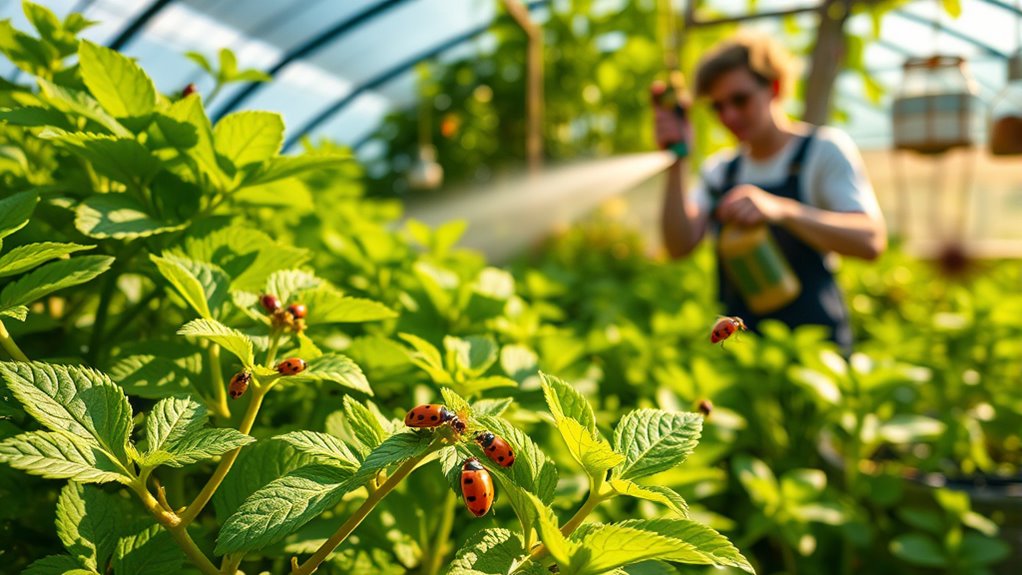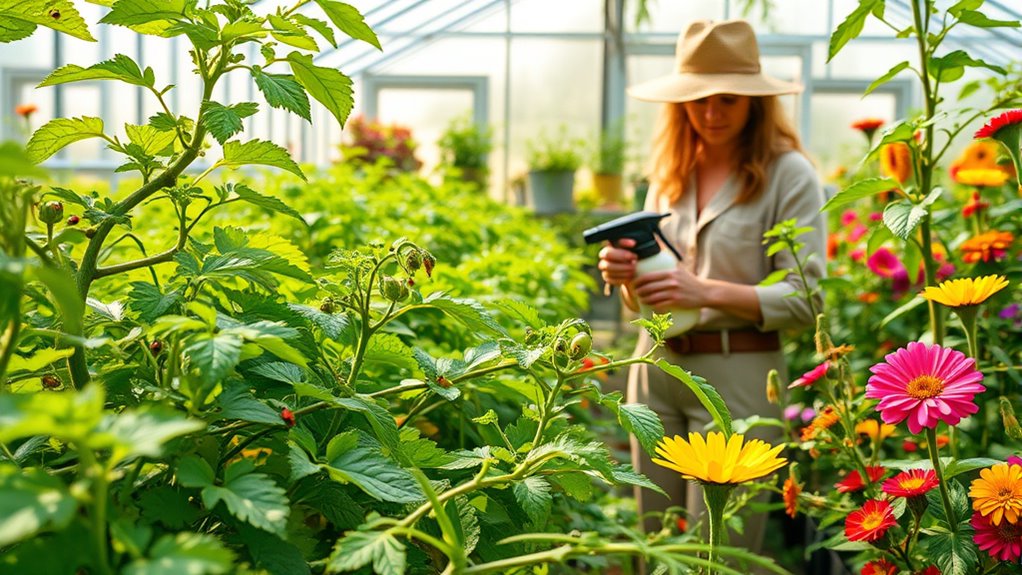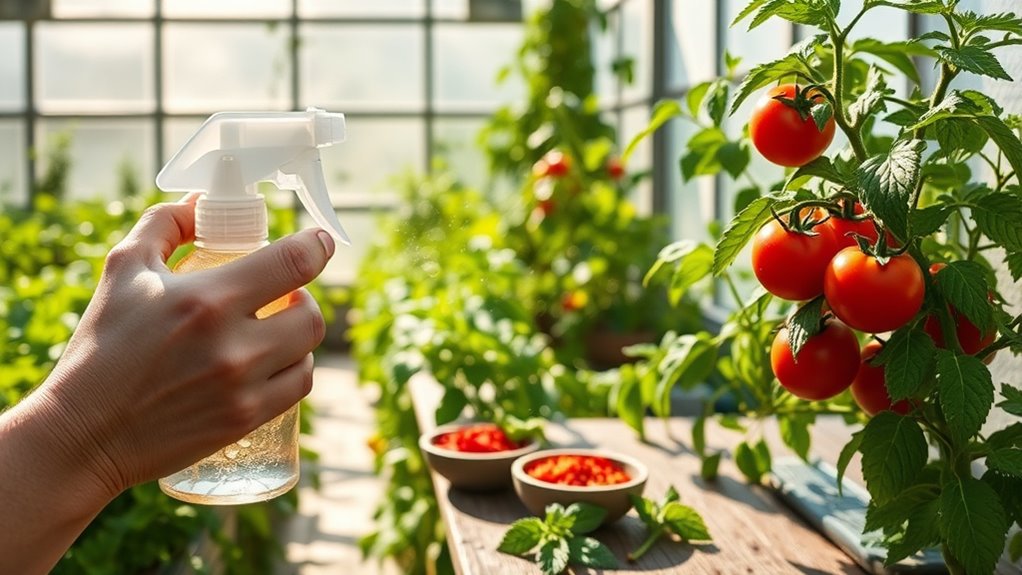To manage pests in your greenhouse naturally, start by monitoring plants regularly for signs of trouble. Implement preventive measures like installing insect screens and keeping the area clean. Use companion planting to attract beneficial insects and create natural barriers. Explore biological controls such as beneficial nematodes or parasitic insects to maintain balance. Homemade remedies, like neem oil and garlic sprays, also help keep pests at bay. Want to discover even more effective strategies?
Key Takeaways
- Utilize companion planting to enhance biodiversity and naturally deter pests, such as pairing tomatoes with basil.
- Release beneficial insects like *Aphidius colemani* for biological pest control, targeting specific pests without harmful chemicals.
- Implement physical barriers, such as screens and crushed stone, to prevent pest entry and protect crops.
- Regularly monitor plant health and pest populations using sticky traps and indicator plants for early detection.
- Create homemade remedies, such as neem oil and garlic spray, to disrupt pest life cycles naturally and safely.
Understanding Common Greenhouse Pests

Greenhouses can be home to a variety of common pests that threaten your plants’ health. You might encounter aphids, which are small, soft-bodied insects that feed on sap, causing curled leaves. Aphids reproduce rapidly, leading to exponential population growth if not managed early. Regularly inspecting your plants for signs of edible plants can help you identify and address pest issues before they escalate. Implementing natural pest control methods can significantly reduce the reliance on chemical treatments. Additionally, leveraging AI-driven analytics can help monitor pest populations and improve management strategies.
Fungus gnats, tiny flies, can damage roots and lead to wilting. Mealybugs, covered in a white waxy substance, suck sap, weakening your plants. Spider mites, barely visible, leave stippling and fine webs on leaves, while thrips create mottled surfaces and can transmit viruses. Identifying these pests early is vital for effective management. Look for signs like colonies, webbing, or stippling.
The Importance of Regular Monitoring

While managing pests in your greenhouse, regular monitoring plays an essential role in maintaining plant health and preventing infestations. By keeping an eye on your plants, you can detect pests early, allowing for timely intervention before they spread. This proactive approach helps you track pest populations, guiding your decision-making on the best control methods. Using indicator plants and sticky traps enhances your monitoring efforts, providing ongoing data about pest population development rates. Regular inspections of randomly selected plants guarantee you’re always aware of potential issues. Plus, keeping detailed records aids in identifying infestation sources and evaluating your control measures. Additionally, utilizing backyard greenhouses can create a controlled environment that supports healthier plants. Furthermore, understanding financial considerations in your pest management approach can help allocate resources more effectively. Ultimately, consistent monitoring leads to healthier crops and efficient resource use in your pest management strategies, as advance directives can guide decisions regarding care if pest issues escalate significantly.
Effective Preventive Measures

To effectively manage pests in your greenhouse, implementing preventive measures is essential.
Start by installing insect screens on all air intakes to keep pests out. Use airlocks or vestibules at entry points for cleaner access and reduced pest introduction. Choose the right screen mesh size to exclude specific pests, like western flower thrips, while ensuring adequate airflow to prevent any reduction. Selecting the right screen mesh size is crucial for effective pest control.
Regularly remove plant debris and weeds to eliminate hiding spots for pests, and clean equipment to prevent pest habitats. Control humidity and temperature to minimize plant stress and prevent pest proliferation. Additionally, maintaining cleanliness by removing plant debris ensures that pests have fewer places to hide and breed. Incorporating pest-resistant plant varieties can further enhance your greenhouse’s defenses. Adopting crop rotation techniques can also help disrupt pest life cycles and improve soil health.
Finally, consider selecting pest-resistant plant varieties and practicing crop rotation to disrupt pest life cycles. These strategies will help you maintain a healthier greenhouse environment.
Companion Planting Strategies

Companion planting strategies can transform your greenhouse into a thriving ecosystem, enhancing both plant health and productivity. By planting diverse species together, you mimic natural ecosystems that promote mutual benefits, such as pest control and nutrient enhancement. This method optimizes your greenhouse’s space, utilizing both vertical and horizontal areas effectively. For example, pairing tomatoes with basil not only deters pests but may also enhance flavor. Additionally, chia seeds, known for their high fiber content, can be incorporated into compost to improve soil health and moisture retention. Similarly, carrots thrive alongside onions, which keep carrot flies at bay. Additionally, companion planting attracts beneficial insects, which provides natural defenses against common pests, improving overall plant health. Furthermore, implementing emotional regulation techniques can help gardeners manage stress, allowing for a more focused and nurturing environment for plant growth. Moreover, using natural pest control methods can further enhance the effectiveness of companion planting by reducing reliance on chemical pesticides.
Additionally, companion planting improves soil health and attracts pollinators, boosting crop yields. To get started, plan your layout carefully, encourage biodiversity, and rotate plant pairings seasonally to maintain soil robustness and pest resistance.
Utilizing Natural Barriers and Repellents

Building on the benefits of companion planting, utilizing natural barriers and repellents can further enhance your greenhouse’s defenses against pests.
You can create physical barriers using crushed stone or gravel to keep unwanted pests at bay. Coffee grounds and eggshells deter slugs and caterpillars with their rough texture. Installing physical screens guarantees that insect pests stay out while allowing air circulation. Sanitation and cultural practices ensure that your greenhouse remains a clean and healthy environment, further supporting these natural defenses. Additionally, maintaining clean air through HEPA filters can help reduce airborne pests and pathogens that may invade your greenhouse. Incorporating organic materials like chia seeds into your pest management strategy can also provide nutritional benefits to beneficial insects. Furthermore, using high-quality pellets for companion planting can help enhance the overall health of your plants.
For natural repellents, consider applying essential oils, garlic spray, or hot pepper spray to discourage pests without harming your plants. Neem oil is another effective option, acting as a natural pesticide.
Implementing Biological Controls

While managing pests in your greenhouse, implementing biological controls offers a sustainable and effective strategy.
You can introduce predatory insects like ladybugs and lacewings to feed on pests such as aphids and thrips. Parasitic insects, like *Aphidius colemani*, attack specific pests, providing targeted control. Consider using fungal pathogens, such as *Beauveria bassiana*, to infect pests or beneficial nematodes to target soil-dwelling threats. Choose the right agents based on your pest type and environmental conditions, and release them early in infestations for best results. Biological control typically does not eliminate target pests entirely but helps to keep their populations in check. Additionally, using high-quality equipment for monitoring can enhance the effectiveness of your biological control methods. Furthermore, utilizing eco-friendly practices such as releasing beneficial insects can create a more balanced greenhouse environment. It’s also beneficial to explore farm museums that showcase sustainable farming practices, providing inspiration for your pest management strategies.
Regular monitoring is essential to assess their effectiveness, and keep in mind that these agents may require ongoing management and proper conditions to thrive. Integrating these methods into your approach enhances overall pest management.
Homemade Remedies for Pest Control

If you want to manage pests in your greenhouse effectively, homemade remedies can be a powerful tool at your disposal.
Try mixing kelp extract with dish soap to control aphids while providing a foliar boost. For a potent repellent, blend hot peppers and garlic with water to deter aphids, thrips, and spider mites. Neem oil mixed with mild soap disrupts pest life cycles without harming beneficial insects. Eucalyptus oil can keep flies and beetles away due to its strong aroma. Additionally, a simple soap spray can disrupt soft-bodied insects’ cell membranes. Finally, consider using natural barriers like coffee grounds to deter slugs and crushed eggshells to repel pests while enhancing soil health. Regular monitoring is essential to prevent pest infestations and ensure the effectiveness of these homemade solutions. Incorporating balanced nutrition into your gardening practices can also enhance plant resilience against pests. Maintaining an organized greenhouse space can also contribute to mental clarity and help you stay focused on pest management efforts.
Innovative Trapping Methods

Homemade remedies can be effective for managing pests, but innovative trapping methods offer a more proactive approach. Mass trapping uses numerous traps to considerably reduce pest populations in your greenhouse, which reduces pesticide needs. Sticky traps, especially yellow ones, are perfect for capturing whiteflies and other flying pests. You might also consider pheromone traps that target specific pest species, enhancing your pest control efforts.
Additionally, trap plants can lure pests away from your valuable crops, making them an excellent strategy. You can place sticky tape at ground level to catch fungus gnats or use scissor carts with sticky tape for moving through rows.
Frequently Asked Questions
How Do I Identify Specific Pest Species in My Greenhouse?
To identify specific pest species in your greenhouse, start with regular plant inspections, looking for signs like curled leaves or webbing.
Use sticky traps to catch flying pests, and consider placing indicator plants to attract them.
Document your findings to track pest populations and patterns.
Familiarize yourself with common pests like aphids and spider mites, so you can quickly recognize and respond to infestations before they escalate.
Regular monitoring is key!
What Are the Signs of a Severe Pest Infestation?
When you notice severe pest infestations, you’ll see significant signs like distorted growth, leaf discoloration, and stunted plants.
Look for sticky residues, webbing, or small clouds of insects when you disturb the foliage.
You might also observe black or brown spots on leaves, indicating damage.
If you spot ants, especially around sticky substances, that’s a warning sign too.
Keep an eye out for these indicators to protect your plants effectively.
Can I Use Chemical Pesticides in a Greenhouse?
Chemical choices can be considered in your greenhouse, but you’ve gotta be careful.
Complying with regulations is essential for safety and effectiveness. Always check the pesticide label for proper application methods and worker protection protocols.
Remember, ventilation’s important after spraying to guarantee safety. Consider the impact on beneficial organisms and the environment, too.
Weigh your options wisely to protect both your plants and the people working in your greenhouse.
How Often Should I Change My Pest Management Strategies?
You should change your pest management strategies regularly to stay effective.
Seasonal adjustments are essential, as pest populations fluctuate with the climate.
Monitor your plants closely and adapt based on their life cycles and environmental conditions.
Keep an eye on new technologies and methods that may emerge.
Finally, evaluate your strategies consistently to confirm they’re working, and don’t hesitate to collaborate with others for fresh insights and improvements.
What Plants Are Most Resistant to Pests in Greenhouses?
Imagine a garden that thrives, untouched by pests—it’s possible with the right plants!
You’ll want to contemplate varieties like kale, cabbage, and certain herbs, which resist common nuisances. Marigolds can act like little bodyguards, protecting your prized greens.
Additionally, experimenting with hybrid plants could yield even stronger defenses. Keep an eye on your crop rotation and record their responses to pests.
With these strategies, your greenhouse will flourish like a well-tended masterpiece.
Conclusion
As you step back and survey your thriving greenhouse, a nagging question lingers: what if pests strike unexpectedly? By embracing these natural and chemical-free pest management strategies, you can fortify your plants against potential invasions. Each preventive measure you implement adds a layer of protection, transforming your greenhouse into a sanctuary. But remember, vigilance is key. The battle against pests is ongoing, and your next move could mean the difference between flourishing plants and a garden in distress. Stay prepared!










